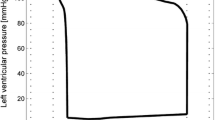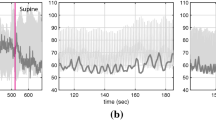Abstract
The complexity of mathematical models describing the cardiovascular system has grown in recent years to more accurately account for physiological dynamics. To aid in model validation and design, classical deterministic sensitivity analysis is performed on the cardiovascular model first presented by Olufsen, Tran, Ottesen, Ellwein, Lipsitz and Novak (J Appl Physiol 99(4):1523–1537, 2005). This model uses 11 differential state equations with 52 parameters to predict arterial blood flow and blood pressure. The relative sensitivity solutions of the model state equations with respect to each of the parameters is calculated and a sensitivity ranking is created for each parameter. Parameters are separated into two groups: sensitive and insensitive parameters. Small changes in sensitive parameters have a large effect on the model solution while changes in insensitive parameters have a negligible effect. This analysis was successfully used to reduce the effective parameter space by more than half and the computation time by two thirds. Additionally, a simpler model was designed that retained the necessary features of the original model but with two-thirds of the state equations and half of the model parameters.






Similar content being viewed by others
References
Banks H, Bortz D. A parameter sensitivity methodology in the context of HIV delay equation models. J Math Biol 2005;50(6):607–25.
Beneken J, DeWit B. A physical approach to hemodynamic aspects of the human cardiovascular system. In: Reeve E, Guyton A, editors. Physical bases of circulatory transport: regulation and exchange. Philadelphia: W.B. Saunders; 1967. p. 1–45.
Bischoff K, Brown R. Drug distribution in mammals. Chem Eng Prog Symp Ser 1966;50(66):33–45.
Boron W, Boulpaep E. Medical physiology. Philadelphia: Elsevier; 2003.
Bortz B, Nelson P. Sensitivity analysis of nonlinear lumped parameter models of hiv infection dynamics. J Math Biol 2004;66(5):1009–26.
Carmichael G, Sandu A, Potra F. Sensitivity analysis for atmospheric chemistry models via automatic differentiation. Atmos Environ 1997;31(3):475–89.
Chen X, Qi L, Teo K-L. Smooth convex approximation to the maximum eigenvalue function. J Global Opt 2004;30:253–70.
Coleman T, Verma A. ADMAT: an automatic differentiation toolbox for matlab. Technical report, Computer Science Department, Cornell University, NY; 1998.
Danielsen M, Ottesen J. Describing the pumping heart as a pressure source. J Theo Biol 2001;212:71–81.
Ebert T. Sensitivity of fitness to macro-parameter changes: an analysis of survivorship and individual growth in sea urchin life histories. Oecologia 1985;65:461–7.
Eslami M. Theory of sensitivity in dynamic systems: an introduction. Berlin: Springer-Verlag; 1994.
Forth S, Ketzscher R. High-level interfaces for the MAD (Matlab Automatic Differentiation) package. In: Neittaanmäki P, et al. editors. ECCOMAS 2004: fourth European congress on computational methods in applied sciences and engineering. European Community on Computational Methods in Applied Sciences; 2004.
Frank P. Introduction to sensitivity theory. New York: Academic Press; 1978.
Heldt T, Shim E, Kamm R, Mark R. Computational modeling of cardiovascular response to orthostatic stress. J Appl Physiol 2002;92(3):1239–54.
Hwang J-T, Dougherty E, Rabitz S, Rabitz H. The Green’s function method of sensitivity analysis in chemical kinetics. J Chem Phys 1978;69(11):5180–91.
Kappel F, Peer R. A mathematical model for fundamental regulation processes in the cardiovascular system. J Math Biol 1993;31(6):611–31.
Kelley C. Iterative methods for optimization. Philadelphia: Society for Industrial and Applied Mathematics; 1999.
Middleman S. Transport phenomena in the circulatory system. New York: Wiley-Interscience; 1972.
Nadler S, Hidalgo J, Bloch T. Prediction of blood volume in normal human adults. Surgery. 1962;51:224–32.
Novak V, Hu K, Vyas M, Lipsitz L. Cardiolocomotor coupling in young and elderly people. J Gerontol A Biol Sci Med Sci 2007;62(1):86–92.
Olufsen M, Tran H, Ottesen J. Modeling cerebral blood flow control during posture change from sitting to standing. J Cardiovasc Eng 2004;4(1):47–58.
Olufsen M, Tran H, Ottesen J, Ellwein L, Lipsitz L, Novak V. Blood pressure and blood flow variation during postural change from sitting to standing – modeling and experimental validation. J Appl Physiol 2005;99(4):1523–37.
Olufsen M, Tran H, Ottesen J, Lipsitz L, Novak V. Modeling baroreflex regulation of heart rate during orthostatic stress. Am J Physiol 2006;291:R1355–68.
Ottesen J. Modeling of the baroreflex-feedback mechanism with time-delay. J Math Biol 1997a;36:41–63.
Ottesen J. Nonlinearity of baroreceptor nerves. Surv Math Ind 1997b;7:187–201.
Ottesen J, Danielsen M. Modeling ventricular contraction with heart rate changes. J Theo Biol 2003;222(3):337–46.
Rabitz H, Kramer M, Dacol D. Sensitivity analysis in chemical kinetics. Ann Rev Phys Chem 1983;34:419–61.
Rideout V. Mathematical and computer modeling of physiological systems. New Jersey: Prentice Hall; 1991.
Thomaseth K, Cobelli C. Generalized sensitivity functions in physiological identification. Ann Biomed Eng 1999;27:607–16.
Ursino M. Interaction between carotid baroregulation and the pulsating heart: a mathematical model. Am J Physiol 1998;44:H1733–47.
Acknowledgments
The authors wish to thank the American Institute of Mathematics for supporting this work. Authors would like to acknowledge Dr. Fink, Department of Mathematics, University of Oxford, UK, who developed the Matlab code for automatic differentiation. The work by M. S. Olufsen and H. T. Tran was supported in part by NSF-DMS Grant # 0616597. H. T. Tran was supported by NIH under Grant 9 R01 AI071915-05. C. Zapata was supported in part by NSA under Grant H98230-06-1-0098 and NSF under Grant DMS-0552571 as part of the REU summer program. V. Novak, director of the SAFE Laboratory at BIMDC was supported by NIH-NIA Harvard Older American Independence Center 2P60 AG08812-11A1, Core B.
Author information
Authors and Affiliations
Corresponding author
Appendix
Appendix
Equations, Full Model
-
(1)
Compartment ODE’s:
$$ \begin{aligned} \frac{dp_{\rm a}}{dt} &= \left(\frac{p_{\rm lv}(t)-p_{\rm a}(t)}{R_{\rm av}}-\frac{p_{\rm a}(t)-p_{\rm au}(t)}{R_{\rm au}}- \frac{p_{\rm a}(t)-p_{\rm ac}(t)}{R_{\rm ac}}-\frac{p_{\rm a}(t)-p_{\rm af}(t)}{R_{\rm af}}\right)/C_{\rm a}\\ \frac{dp_{\rm au}}{dt}&= \left(\frac{p_{\rm a}(t)-p_{\rm au}(t)} {R_{\rm au}}-\frac{p_{\rm au}(t)-p_{\rm al}(t)}{R_{\rm al}}- \frac{p_{\rm au}(t)-p_{\rm vu}(t)}{R_{\rm aup}}\right)/C_{\rm au} \\ \frac{dp_{\rm al}}{dt}&= \left(\frac{p_{\rm au}(t)-p_{\rm al}(t)}{R_{\rm al}} -\frac{p_{\rm al}(t)-p_{\rm vl}(t)}{R_{\rm alp}}\right)/C_{\rm al} \\ \frac{dp_{\rm af}}{dt}&= \left(\frac{p_{\rm a}(t)-p_{\rm af}(t)}{R_{\rm af}} - \frac{p_{\rm af}(t)-p_{\rm v}(t)}{R_{\rm afp}}\right)/C_{\rm af} \\ \frac{dp_{\rm ac}}{dt}&= \left(\frac{p_{\rm a}(t)-p_{\rm ac}(t)}{R_{\rm ac}} -\frac{p_{\rm ac}(t)-p_{\rm vc}(t)}{R_{\rm acp}}\right)/C_{\rm ac} \\ \frac{dp_{\rm v}}{dt} &= \left(\frac{p_{\rm vu}(t)-p_{\rm v}(t)} {R_{\rm vu}} +\frac{p_{\rm vc}(t)-p_{\rm v}(t)}{R_{\rm vc}}+ \frac{p_{\rm af}(t)-p_{\rm v}(t)}{R_{\rm afp}} -\frac{p_{\rm v}(t)-p_{\rm la}(t)}{R_{\rm v}}\right)/C_{\rm v} \\ \frac{dp_{\rm vu}}{dt}&=\left(\frac{p_{\rm vl}(t)-p_{\rm vu}(t)}{R_{\rm vl}} +\frac{p_{\rm au}(t)-p_{\rm vu}(t)}{R_{\rm aup}} - \frac{p_{\rm vu}(t)-p_{\rm v}(t)}{R_{\rm vu}}\right)/C_{\rm vu} \\ \frac{dp_{\rm vl}}{dt}&= \left(\frac{p_{\rm al}(t)-p_{\rm vl}(t)} {R_{\rm alp}}-\frac{p_{\rm vl}(t)-p_{\rm vu}(t)}{R_{\rm vl}}\right)/C_{\rm vl} \\ \frac{dp_{\rm vc}}{dt} &=\left(\frac{p_{\rm ac}(t)-p_{\rm vc}(t)}{R_{\rm acp}} -\frac{p_{\rm vc}(t)-p_{\rm v}(t)}{R_{\rm vc}}\right)/C_{\rm vc} \\ \frac{dV_{\rm lv}}{dt}&= \frac{p_{\rm la}(t)-p_{\rm lv}(t)} {R_{\rm mv}(t)} -\frac{p_{\rm lv}(t)-p_{\rm a}(t)}{R_{\rm av}(t)} \\ \frac{dV_{\rm la}}{dt}&= \frac{p_{\rm v}(t)-p_{\rm la}(t)} {R_{\rm v}}-\frac{p_{\rm la}(t)-p_{\rm lv}(t)}{R_{\rm mv}(t)} \end{aligned} $$Parameters include R i (mmHg s/cm3), C i (cm3/mmHg).
-
2)
Valve equations R av, R mv, R vu:
$$ \begin{aligned} R_{\rm av}&=\min(R_{\rm av,open} + e^{(-2(p_{\rm lv}-p_{\rm a}))},20)\\ R_{\rm mv}&=\min(R_{\rm mv,open} + e^{(-2(p_{\rm la}-p_{\rm lv}))},20)\\ R_{\rm vu}&=\min(R_{\rm vu,open} + e^{(-2(p_{\rm vu}-p_{\rm v}))},20) \end{aligned} $$ -
3)
Left atrium and ventricle:
$$ \begin{aligned} p_j(t) &= a_j(V_j(t)-b_j)^2+(c_j V_j(t)-d_j)f_j(t), \quad j = \hbox{lv, la} \\ f_j(t) &= \left\{ \begin{array}{ll} \tilde{p}_j(H)\frac{\tilde{t}^{n_j}(\beta(H)-\tilde{t})^m_j} {n_j^{n_j}m_j^{m_j}[(\beta_j(H))/(m_j+n_j)]^{m_j+n_j}} & 0 \leq \tilde{t} \leq \beta_j(H)\\ 0 & \beta_j(H) < \tilde{t} < T \end{array}\right.\\ \tilde{t} &= \hbox{mod}(t,T) \\ t_j &= (t_{diff,j}) \frac{\theta_j^{\nu_j}} {H^{\nu_j}+\theta_j^{\nu_j}}+t_{{\rm min},j}\\ \tilde{p}_j &= (p_{diff,j}) \frac{H^{\eta_j}} {H^{\eta_j}+\phi_j^{\eta_j}}+p_{{\rm min},j}\\ \beta_j(H)&= \frac{n_j+m_j}{n_j}t_j(H) \\ \end{aligned} $$
Equations, Reduced Model
-
(1)
Compartment ODE’s:
$$ \begin{aligned} \frac{dp_{\rm a}}{dt}&= \left(\frac{p_{\rm lv}-p_{\rm a}}{R_{\rm av}}-\frac{p_{\rm a}-p_{\rm as}} {R_{\rm as}}- \frac{p_{\rm a}-p_{\rm ac}}{R_{\rm ac}}\right)/C_{\rm a}\\ \frac{dp_{\rm v}}{dt}&=\left(\frac{p_{\rm vs}-p_{\rm v}}{R_{\rm vs}}+\frac{p_{\rm vc}-p_{\rm v}}{R_{\rm vc}} -\frac{p_{\rm v}-p_{\rm lv}}{R_{\rm mv}}\right)/C_{\rm v}\\ \frac{dp_{\rm as}}{dt}&= \left(\frac{p_{\rm a}-p_{\rm as}}{R_{\rm as}} -\frac{p_{\rm as}-p_{\rm vs}}{R_{\rm asp}}\right)/C_{\rm as} \\ \frac{dp_{\rm vs}}{dt}&= \left(\frac{p_{\rm as}-p_{\rm vs}}{R_{\rm asp}} -\frac{p_{\rm vs}-p_{\rm v}}{R_{\rm vs}}\right)/C_{\rm vs} \\ \frac{dp_{\rm ac}}{dt}&= \left(\frac{p_{\rm a}-p_{\rm ac}}{R_{\rm ac}} -\frac{p_{\rm ac}-p_{\rm vc}}{R_{\rm acp}}\right)/C_{\rm ac} \\ \frac{dp_{\rm vc}}{dt}&= \left(\frac{p_{\rm ac}-p_{\rm vc}}{R_{\rm acp}} -\frac{p_{\rm vc}-p_{\rm v}}{R_{\rm vc}}\right)/C_{\rm vc} \\ \frac{dV_{\rm lv}}{dt}&= \frac{p_{\rm v}-p_{\rm lv}}{R_{\rm mv}} -\frac{p_{\rm lv}-p_{\rm a}}{R_{\rm av}} \end{aligned} $$ -
(2)
Valve equations, R av, and R mv:
$$ \begin{aligned} R_{\rm mv}&=\hbox{min}(R_{\rm mv,open}+e^{(-2(p_{\rm v}-p_{\rm lv}))},20)\\ R_{\rm av}&=\hbox{min}(R_{\rm av,open}+e^{(-2(p_{\rm lv}-p_{\rm a}))},20) \end{aligned} $$ -
(3)
Left ventricle: Equations for the left ventricle are identical to those displayed above.
Rights and permissions
About this article
Cite this article
Ellwein, L.M., Tran, H.T., Zapata, C. et al. Sensitivity Analysis and Model Assessment: Mathematical Models for Arterial Blood Flow and Blood Pressure. Cardiovasc Eng 8, 94–108 (2008). https://doi.org/10.1007/s10558-007-9047-3
Published:
Issue Date:
DOI: https://doi.org/10.1007/s10558-007-9047-3




